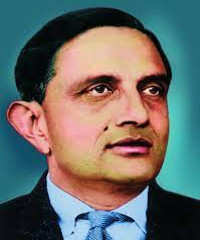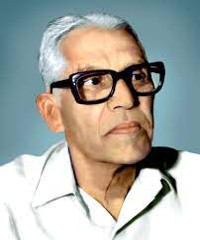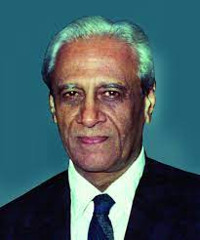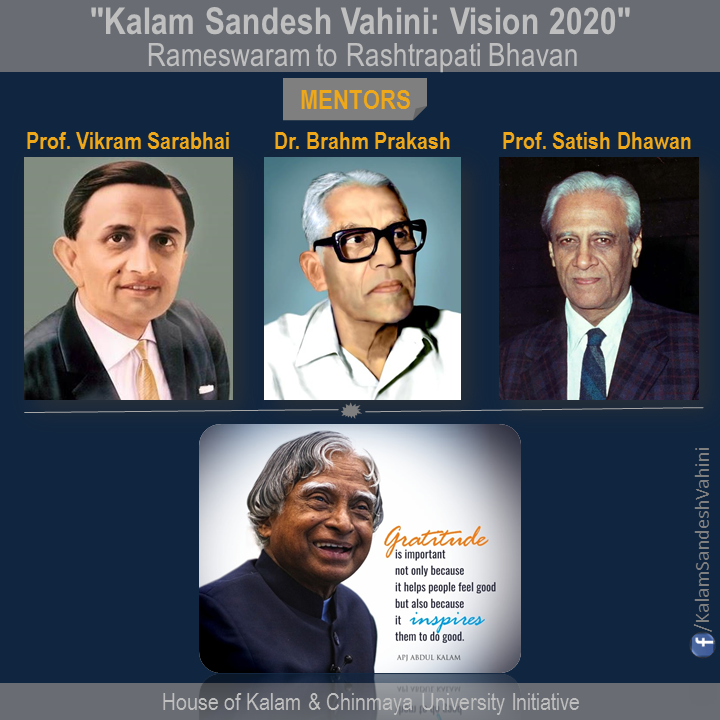The Trinity of Indian Space Programme
AVATARS OF ACTION AND COMPASSION
MY ENCOUNTER
The Trinity of Indian Space Programme
Y.S Rajan remembers the stalwarts of the Indian Space Programme
When I began my research career at Ahmedabad in 1964, benefits from the Space Technology, even worldwide, had just begun to surface. The potentials were talked about; NASA was active. The then Soviet Union was active. There was a Space race. Very few in India could even think that it could be relevant to India and the Indian people, when the country was mired in poverty, severe food shortages, even a humiliation by China in 1962, constant war like situation with Pakistan, a lot of promises by the politicians with very little on the ground.
It was in such a milieu Dr. Vikram Sarabhai had convinced the government to get some meagre funds to begin the Space Program.

Out of many potential benefits, he chose four items of applications to concentrate upon:
- Reaching telecommunications to a large part of our country
- To reach TV to all the villages in India, so that the educational and developmental messages can reach the vast rural population. That was to help them to better their lives.
- Rapid survey of the natural resources of the country like land, forest, water, agriculture, geology etc. so that they can be better utilized for economic growth and also to monitor various degradation of the land to rectify them.
- Better weather forecast and monitoring of weather related disasters like cyclones, which devastated the country every year.
With meagre government resources, he used his contacts worldwide: USA, France, USSR, Japan and others to get free rockets and some training for scientific experiments. He also simultaneously started building up a space technology base in the country. Beg, borrow, do lot of hard work; undeterred by failures, which was common to such an emerging technology. He was also aware that the developed countries would deny technology once India starts learning and doing! Such is the techno-power politics of the world. True even now.
He belonged to a rich business family. He did a lot to grow the family businesses. But when the load of growing space program needed all his attention, he left the family businesses to other members. He struggled a lot to build the Indian space program.
I joined his early team in about a year of its start. As a young man in my twenties, they were powerful goals (not pipe dreams) as we understood the technological possibilities that had just risen in the horizon in the developed countries.
Many now won’t have an idea as to how India was in the 1960’s, 1970’s and even later. Indians now have access to more than 300 TV channels in all Indian languages. They have many choices: films, serials, religious shows, cooking, sports, educational, adventure, news, foreign channels etc. It is a problem of plenty, with many middle-class houses having two TV sets. Some see them also in their mobiles.
In the 1980’s even telephones were considered as luxury. Several years of waiting to get a telephone. Public booths were a nightmare. Now there is a mobile with a street hawker, construction worker and women at home.
All these are now possible because of the trigger given the Indian National Satellite INSAT, which started covering all of India, at one stroke in 1983. Telephone capacity addition which took 15 years before the coming of INSAT, were added in 18 months. TV could reach anywhere in India. Such was the rapidity of expansion of telephone and TV in India. What is now plenty is due to the massive trigger given by space technology.
Look at the home delivery of items you order online. It would be impossible without the satellite based Global Positioning System (GPS) and the satellite images based maps giving Geographic Information System (GIS). I will not elaborate on them. Readers are advised to hear my YouTube talk delivered at IIT Hyderabad Extra Mural Lectures (EML), delivered on August 14, 2021. It can also be accessed from my website www.ysrajan.com (Impact of Space Technology on Improving Quality of Life).
The above-mentioned items are not just for entertainment alone. They are the main story of economic growth and employment. Without them, India would be struggling as an agricultural country.
Beyond these economic items, look at the human dimension:
During 1977 east coast cyclone, Andhra Pradesh had a death toll of 10,000 people. Equally, severe cyclone in 1996 had 1077 deaths with 225,000 families evacuated. Recent severe 2014 cyclone had only 61 deaths.
Why such a reduction? INSAT had (has) a meteorological instrument which can track the cyclone even when it begins in the sea and see its progress every 30 minutes. Along with ground radars, it can track change of paths. It involves a huge network, cluster of things, I have explained in the lecture quoted earlier. Even when telecom towers are cut off, the rescue workers with small backpacks can communicate through satellites with battery operated systems.
These all came from the clarity of vision of Sarabhai to begin with. He was a man of action with lot of compassion for Indian people. He could not live to see them all.
He died young when he was just 52, in December 1971. He had left behind many young men and women who started mastering space technology and application. I am one in the few hundreds of them when he left us.
Still ISRO he nucleated and built, was a fledgling organization. If you look back the history of post independence India, there are many initiatives, which die slowly after the initiator leaves or passes away. Many good companies in public sector have perished this way. Many national laboratories and educational institutions reach a low plateau and survive with nothing much to show as achievements. Even many agricultural or road projects or river projects have suffered such a fate. It is sad.
Indian Space Program was fortunate not to suffer the fate. Though the Destiny took away the initiating avatar, immediately following his passing away two others came to rescue it, in the transition period and to make it work towards the goals with which the program was started by Sarabhai. In fact, the two persons made solid foundation and established sustainable systems within the organization to make many more achievements not just stagnant with initial targets, but to go beyond in keeping with world developments. It became world class!
It is this TRINITY, which rarely occurs in India, Sarabhai (1963-1971), Satish Dhawan (1972-1984) and Brahm Prakash (1972-1979).
We will briefly look at what happened with the other two persons of the TRINITY and what lessons we can learn for the present and the future.
Sarabhai had a good blend of business and science knowledge in him, thus giving viable and economically crucial goals for ISRO, Satish Dhawan who succeeded was a great world-class engineer-scholar with aeronautics background and was the Director Indian Institute of Science. He did not have a direct experience of handling a delivery bound organization, as ISRO was cast by Sarabhai.

The number two person, though not exactly named so, was Dr. Brahm Prakash (BP as he was fondly called in ISRO) was a US trained metallurgist and scholar. Bhabha brought him to India. BP had built up several public sector delivery companies under Atomic Energy Department like Uranium Corp. of India, Midhani - a high tech alloy company, Nuclear Fuel Complex etc...
After the early death of Homi Bhabha in air accident, Sarabhai took charge of Atomic Energy, and he gave many more projects to BP. He did very good work. By googling Brahm Prakash ISRO you will see more about him. Notable are an article by C V Sundaram and one that appeared in INSA.
After Sarabhai’s death, the transition “politics” within Atomic Energy establishment sidelined BP. He was picked up to take charge of Vikram Sarabhai Space Centre (consolidating many independent units which were directly under Sarabhai in Thiruvananthapuram, then called Trivandrum). In Satish Dhawan’s words, which he said later, “VSSC is the heart of technology of ISRO”. It had more than 75% of ISRO budget. Dr. BP was eight years elder to Satish Dhawan (SD).
There are some unique features both of them had in common and in some different. Overall, they were complimentary and supplementary.

Both were men of great personal and professional integrity. They subsumed their egos so that ISRO can grow and achieve. Especially in India, many persons who come and take charge, try to change projects and programs with a false ego of leaving their “imprint.” SD and BP built what was left behind by Sarabhai and corrected a number of problem areas without any fanfare. In the initial period, Sarabhai had large number of independent units directly reporting to him in order to give them the freedom to initiate and experiment. But as they grew the need for consolidating them was getting very clear as the independent units showed conflicts detrimental to delivery of the big projects outlined by Sarabhai.
First task was to consolidate them into viable components for delivery of projects. BP took the bulk of the load, relieving SD to do tasks of top ISRO management.
In such situations the conflicts of and suspicions between number 1 and 2, debilitate, if not destroy, many organizations. ISRO was fortunate. Again, this consolidation was done without hurting the feelings of many key persons at that time, though all were to come under a firm discipline of the organization, which was transparent.
Another key feature was that organizations like ISRO, which was working on frontline technologies, which were moving fast worldwide, needed a hybrid model of
- doing disciplined project work, and also
- doing some innovative research and development to be ready for a future which would make the achievements already made, obsolete.
Many organizations do not master this art of balancing: either they get trapped in routine mode and become obsolete over a period, not being able to innovate. Or in the name of innovation, go helter skelter and fail on delivery of products or services.
SD & BP were masters in the balancing act and created systems to ensure it, through reviews and protecting small but new innovative works as well. One most important thing done by SD, with full support of BP was to create a TROIKA of balancing the governmental processes and financial rules of dealing with government money without affecting the program. Both were deeply aware of public accountability as they dealt with taxpayers’ money. Unlike the usual Ministries of Government, which control the delivery organizations often detrimentally, the Department of Space (DOS) worked as partner to ISRO: Additional Secretary DOS, Joint Secretary DOS and Scientific Secretary ISRO (representing a band of young scientists in program offices of ISRO) was the Troika.
SD was given all the powers by Government as Chairman ISRO, Secretary DOS and Chairman Space Commission. But he balanced himself against a single person rule through the TROIKA and delegating most of the powers to the Centre Directors like BP.
At this point we need to mention about two angels who helped SD to do, were Additional Secretary, DOS, M.A. Vellodi and Joint Secretary, DOS, T N Seshan.
Those who want to know more about SD shaped ISRO please read my article on Satish Dhawan in my website www.ysrajan.com
At the time of passing away of Dr. BP, we in ISRO had brought out a small brochure. ISRO stalwarts had written on him. I have said in my piece that Dr. BP removed my doubts about the possibility of Dharmaputra on the earth.
SD had said about BP in that document “Dr. Prakash never raised his voice in anger, never missed a schedule or failed to complete responsibility he had undertaken – how do you measure the contribution of such a man? We will all miss him.”
It is God grace, that I had the good fortune of working with and shaped by this TRINITY right from my young age and the angels I mentioned earlier.

They have created many hundreds technology achievers for India. Dr. Kalam is one of them. He mentioned this TRINITY OFTEN.